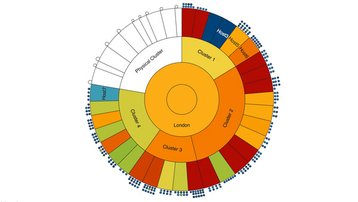While some may have hoped that cloud computing would obviate the need for capacity planning, UK-based Sumerian is offering a more realistic idea - a cloud-based service that does your capacity planning for you.
The service allows customers to upload their current IT estate and any projected changes, getting back capacity projections and “sunburst” visualizations of their future IT infrastructure. It is based on 12 years’ consultancy work by Sumerian, which was founded in 2002.
Although cloud computing was presented as a new era in which capacity could be accessed on demand, this has not emerged in reality, said CTO Peter Duffy in a call with DatacenterDynamics. “No one knows how many resources they have, and if you don’t know, you can’t manage it.”
Light touch, no new agents
Luckily, he says, “cloud is a good fit for capacity management”, as it involves expertise that can be accessed as a what Sumerian is calling capacity planning as a service (CPaaS), without installing new local software.
“We take data from customers and pull it into our environment,” explained Duffy “There are no new agents required - it is a light touch approach.”
The system can draw in information about multiple environments, including VMware and HyperV, as well as linking to existing tools such as CA Unicenter and Tivoli.
CEO David Stevens explained that the service is predictive, not a real-time monitoring solution. It addresses “what-if” questions, with examples on its site including “I am moving to Cisco UCS, how can I streamline my IT?” or “My supplier is ending support for my mainframe, how can I consolidate the loads elsewhere?”
“Our CPaaS shows customers exactly what capacity headroom they have now across their IT estate and makes it easier to accurately forecast for future IT spend,” said Stevens. “It gives IT Department Heads a holistic view of the IT estate and greater insight into how current resources can be optimized, enabling them to make smarter investment decisions.”


